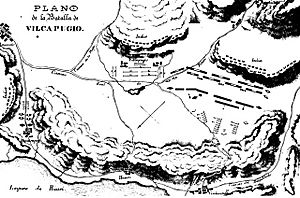Battle of Vilcapugio facts for kids
Quick facts for kids Battle of Vilcapugio |
|||||||
|---|---|---|---|---|---|---|---|
| Part of Bolivian War of Independence Argentine War of Independence |
|||||||
 Old map of the battle |
|||||||
|
|||||||
| Belligerents | |||||||
| Commanders and leaders | |||||||
| Strength | |||||||
| 3,400 soldiers 14 cannon |
3,500 soldiers 12 cannon |
||||||
| Casualties and losses | |||||||
| 350 dead | 200 dead | ||||||
The Battle of Vilcapugio was a big fight that happened on October 1, 1813. It was part of the Argentine War of Independence. In this battle, the forces from the United Provinces (like early Argentina) were led by General Manuel Belgrano. They were defeated by a royalist army, which was led by Joaquin de la Pezuela. The name Vilcapugio means 'Sacred Well'.
The Second Campaign in Upper Peru
After winning battles at Tucumán and Salta, the Army of the North was told to keep fighting in Upper Peru. The government in Buenos Aires really wanted them to continue.
General Belgrano was sick with malaria. He also had to lead new soldiers who didn't have enough cannons. But he still agreed to lead the army.
Belgrano's army got help from other groups. Colonel Baltasar Cárdenas brought 2,000 local people from Oruro. Colonel Cornelio Zelaya brought forces from Cochabamba. Both colonels were told to get local people to fight against the Spanish.
Belgrano knew the royalist army didn't have enough mules to move their cannons and supplies. So, he planned a special attack called a pincer movement. He thought the royalists' lack of movement would help his army win.
The Battle of Vilcapugio
In late September 1813, most of Belgrano's army reached the flat area of Vilcapugio. This place was a plateau surrounded by tall mountains, north of Potosí. The royalist troops were camped further west.
The royalist leaders, Pezuela and Major Saturnino Castro, surprised and defeated Cárdenas's local troops. This happened at Ancacato, about 23 kilometers north of Belgrano's camp. Castro also found documents from Cárdenas that showed Belgrano's plans.
With these documents, Pezuela was able to stop Belgrano's plans. He started moving his army into the mountains on October 1. This was before Zelaya's cavalry from Cochabamba could join Belgrano's army at Vilcapugio.
Belgrano's experienced soldiers fought hard against the royalist army. They pushed the royalists back so much that Pezuela almost thought he had lost the battle. However, the royalists' left side kept fighting and defeated Belgrano's right side.
If Belgrano's army had kept chasing the Spanish troops, they might have won. But then, royalist cavalry led by Saturnino Castro arrived. This made Belgrano's soldiers panic and scatter. The royalist army then regrouped. They captured all of Belgrano's cannons and kept firing at the few soldiers left.
In the end, the royalists won the battle. About 350 of Belgrano's soldiers died, and around 200 royalist soldiers were killed.
What Happened Next
After the battle, Belgrano and Eustaquio Díaz Vélez made a plan. Díaz Vélez would go south to Potosí to gather the scattered troops. Belgrano would collect the rest of his army near the town of Macha, about 65 kilometers to the east.
Díaz Vélez took charge of the troops in Potosí. The army then reorganized itself. They continued the campaign in Alto Perú, following orders from the government in Buenos Aires.
See also
 In Spanish: Batalla de Vilcapugio para niños
In Spanish: Batalla de Vilcapugio para niños

